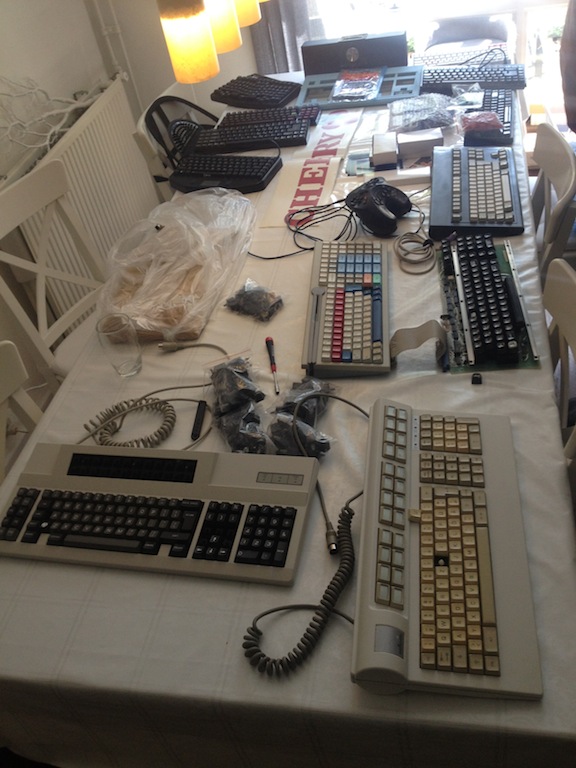Not just any board -- this is "TheBoard"!
Posted: 05 May 2013, 23:35
I found this on ebay and couldn't resist...
This is "TheBoard", first sold in 1985, built by the small German company "Hohe Electronics", and AFAIK the first range of keyboards featuring programmable LCD keys.
This is how it looked before I retrobrighted the keys yesterday.
Futaba switches. These feel strange, a bit flimsy, but not bad. They're tactile when pressing down, and they click when releasing. Overall they're pretty loud. Actuation force is supposed to be at 70 g according to the datasheet I got, but they feel lighter to me, maybe because of their age. I didn't ripster-measure them yet.
I was lucky: the board is fully working.
Keycaps look like this:
They're doubleshot, and I like their unique profile. The manufacturer obviously tried a little too hard here to get the legends nice and thin. All rows have the same profile, so the board is stepped like an old typewriter.
The "String" key allows definition of macro strings on the keyboard. The board has 64K RAM, which is what my C64 had when this model came out in 1985. According to a price list from 1989, the board cost 998 DM + VAT, so it was more expensive than my C64, too.
The board has 24 instead of 12 function keys, and every function key has a 20x8 LCD matrix on it. The LCDs can be programmed using special MS DOS software that comes with the board. I'm stuck here at the moment. The board came with two 5,25" floppy disks containing the software, but my old floppy drive that I got out from a dark corner of my basement yesterday seems not to be able to read the disks (or any disk, for that matter), so I don't know if it's the drive or just the age of the disks that's the problem. Of course I'd rather find some newer software for Windows or Linux for it, but I couldn't find anything yet on that big worldwide network that we use today but nobody really had access to at that time.
According to the data sheet, 4 layers can be defined for every key, so if you press a modifier and have programmed the LCDs accordingly, the displays are supposed to change.
This is "TheBoard", first sold in 1985, built by the small German company "Hohe Electronics", and AFAIK the first range of keyboards featuring programmable LCD keys.
This is how it looked before I retrobrighted the keys yesterday.
Futaba switches. These feel strange, a bit flimsy, but not bad. They're tactile when pressing down, and they click when releasing. Overall they're pretty loud. Actuation force is supposed to be at 70 g according to the datasheet I got, but they feel lighter to me, maybe because of their age. I didn't ripster-measure them yet.
I was lucky: the board is fully working.
Keycaps look like this:
They're doubleshot, and I like their unique profile. The manufacturer obviously tried a little too hard here to get the legends nice and thin. All rows have the same profile, so the board is stepped like an old typewriter.
The "String" key allows definition of macro strings on the keyboard. The board has 64K RAM, which is what my C64 had when this model came out in 1985. According to a price list from 1989, the board cost 998 DM + VAT, so it was more expensive than my C64, too.
The board has 24 instead of 12 function keys, and every function key has a 20x8 LCD matrix on it. The LCDs can be programmed using special MS DOS software that comes with the board. I'm stuck here at the moment. The board came with two 5,25" floppy disks containing the software, but my old floppy drive that I got out from a dark corner of my basement yesterday seems not to be able to read the disks (or any disk, for that matter), so I don't know if it's the drive or just the age of the disks that's the problem. Of course I'd rather find some newer software for Windows or Linux for it, but I couldn't find anything yet on that big worldwide network that we use today but nobody really had access to at that time.
According to the data sheet, 4 layers can be defined for every key, so if you press a modifier and have programmed the LCDs accordingly, the displays are supposed to change.
